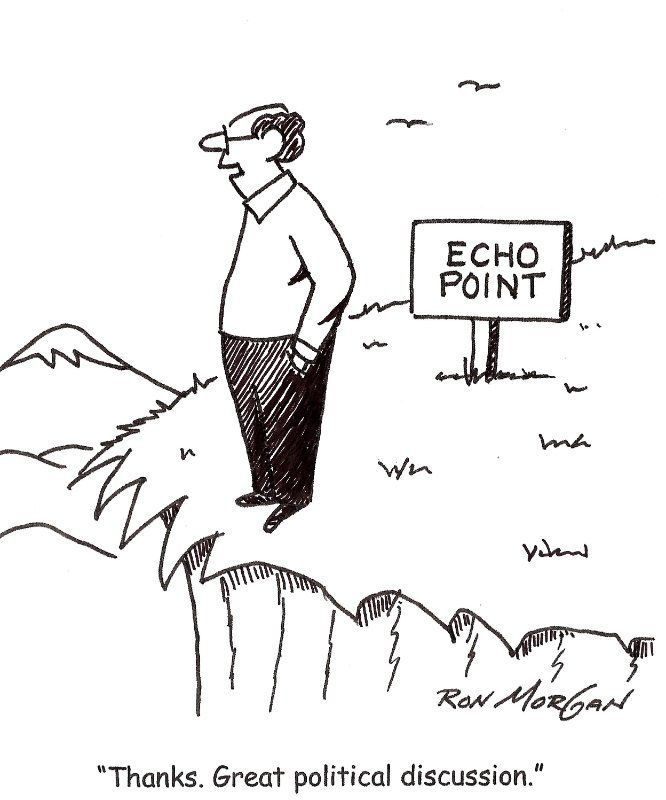
News and Social Media Monitoring
The Fundamentals:

Having found your way to the Echo Chamber Club, it seems safe to assume that you have some idea of what an echo chamber is and why they can be problematic; but probably don’t have an idea of quite the kind of work goes into pushing back against them. Before beginning my work for the ECC I was in the same boat, I had plenty of thoughts about echo chambers as a concept but no understanding of how someone would go about tracking such a thing.
If you need help defining what an echo chamber is I would suggest reading over our FAQ section, but in rough terms, an echo chamber is a space where viewpoints that differ from the norm have little to no chance of making it in.
As an outsider looking in I had no clue how the ECC went about accomplishing its mission. It was only after my introduction to some very interesting research techniques and tools that I finally began to understand how the ECC decides which topic might make for a relevant newsletter. Alice asked me to share my journey with our subscribers, so you could have an insight into how our editorial research works, and also to see if you could think of some easy improvements we might be able to make.
Pinpointing the locations and workings of how the metropolitan community receives information is the first step in combatting echo chambers. In our case, a survey answered by our ECC subscribers helps us understand exactly where this takes place. Basically, this step requires identifying both the political leanings of our readership and the news sites that inform them.
To start we find out where our subscribers go for news which forces us to confront some very important questions, do they actually get their information online, or via offline modes of information distribution? Does social media truly influence what this group thinks? How do the relationships between different types of media work? Are they more likely to share what is on the front page of the news? It turns out that our subscribers go first to the websites of their favourite news sites, then to Facebook, then to Twitter. So, easily accessible online media plays a massive role.

Once we understand this we focus on the specifics. Namely, finding out which news sites is it that our subscribers go to? We found that the Guardian followed by the BBC carries the most influence in this group.

A Look into Discovery:
Finally, we wanted to ensure that our basic assumptions about our subscribers political leanings were correct. We asked about their attitude towards Brexit, and also about their attitude towards cultural appropriation. We received an unsurprising response to the Brexit question, our subscribers disagreed with leaving the EU deeply. In contrast, we were challenged on the cultural appropriation question which our subscribers responded towards ambivalently. This shows us that more extreme leftist opinions are not mainstream in this group, the fact is they are more centrist than we initially expected.


Discovering that digital media is the preferred news source of the metropolitan elite carried a lot of weight for us, primarily by teaching us how different types of digital media cooperate. Social media and news websites are designed to show the reader what they want to see, as they want to boost web traffic and advertising profits. Therefore, what’s trending on social media directly impacts what appears on the front page of certain news websites. This discovery gave us a clear picture of how echo chambers can perpetuate across digital media.
Describing our methodology:
So, we now have a greater insight into how our subscribers access information. In order to properly challenge dominant narratives we need to understand the information these sites give us on a daily basis. As a result, we monitor social media and news headlines every day.
Let’s start by talking about social media monitoring. Monitoring narratives across social media requires carefully creating Twitter lists and pushing them through an application called Nuzzel, which tells us which articles are most popular among metropolitans. Creating Twitter lists capable of doing this requires that we carefully select a sample size of journalists, public intellectuals and otherwise influential figures. Deciding exactly which individuals make the list is a process informed by our previously mentioned survey, as well as a consideration of which voices carry the greatest weight in this community.
Monitoring news websites is exactly what you’d expect. We grab a screenshot of the front pages of influential sites, and double check the articles on them so we understand the point of view they put across. Recording daily notes during this process allows us to clearly see how broader narratives form over time.
While manual, this research is really the only way to get an understanding of how certain stories are pushed to the top of social media feeds, and consequently to the front page of major news sites. Compiling this data is what allows us to gauge exactly which viewpoints are trending in metropolitan echo chambers, and may well benefit from a newsletter.
This work is very important to the Echo Chamber Club as we want to ensure that the newsletters we curate for our audience is not pushing our own individual agendas, but is instead informed by a large body of research. Although it is impossible to always avoid personal bias, we put a lot of effort into remaining as objective as we can.
This Post Has One Comment
Comments are closed.




[…] Otherwise, I’ve been working with an intern Sebastian Ullman on our media and social media monitoring. He’s written a blog post about the information we collect that guides our editorial choices. If you’re interested then take a look here. […]